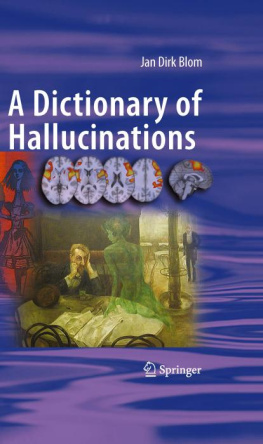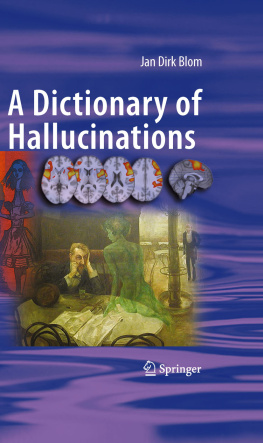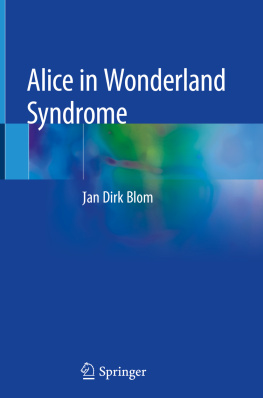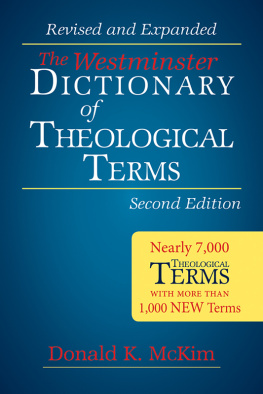 A Dictionary of Hallucinations Jan Dirk Blom A Dictionary of Hallucinations Jan Dirk Blom, M.D., Ph.D. Assistant Professor of Psychiatry Parnassia Bavo Group & University of Groningen Paradijsappelstraat 2 2552 HX The Hague The Netherlands ISBN 978-1-4419-1222-0 e-ISBN 978-1-4419-1223-7 DOI 10.1007/978-1-4419-1223-7 Springer New York Dordrecht Heidelberg London Library of Congress Control Number: 2009937444 Springer Science+Business Media, LLC 2010 All rights reserved. This work may not be translated or copied in whole or in part without the written permission of the publisher (Springer Science+Business Media, LLC, 233 Spring Street, New York, NY 10013, USA), except for brief excerpts in connection with reviews or scholarly analysis. Use in connection with any form of information storage and retrieval, electronic adaptation, computer software, or by similar or dissimilar methodology now known or hereafter developed is forbidden. The use in this publication of trade names, trademarks, service marks, and similar terms, even if they are not identified as such, is not to be taken as an expression of opinion as to whether or not they are subject to proprietary rights. Cover illustration: 1.
A Dictionary of Hallucinations Jan Dirk Blom A Dictionary of Hallucinations Jan Dirk Blom, M.D., Ph.D. Assistant Professor of Psychiatry Parnassia Bavo Group & University of Groningen Paradijsappelstraat 2 2552 HX The Hague The Netherlands ISBN 978-1-4419-1222-0 e-ISBN 978-1-4419-1223-7 DOI 10.1007/978-1-4419-1223-7 Springer New York Dordrecht Heidelberg London Library of Congress Control Number: 2009937444 Springer Science+Business Media, LLC 2010 All rights reserved. This work may not be translated or copied in whole or in part without the written permission of the publisher (Springer Science+Business Media, LLC, 233 Spring Street, New York, NY 10013, USA), except for brief excerpts in connection with reviews or scholarly analysis. Use in connection with any form of information storage and retrieval, electronic adaptation, computer software, or by similar or dissimilar methodology now known or hereafter developed is forbidden. The use in this publication of trade names, trademarks, service marks, and similar terms, even if they are not identified as such, is not to be taken as an expression of opinion as to whether or not they are subject to proprietary rights. Cover illustration: 1.
The Absinthe Drinker. Oil painting (c. 1903) by Viktor Oliva; 2. Alice in Wonderland. Illustration (c. 1865) by John Tenniel 3.
Functional MRI scans of the brain, axial slices, group analysis. The yellow, orange, and red areas represent an increase in the BOLD response concomitant to verbal auditory hallucinatory activity. Scan images courtesy of Dr. Rutger Goekoop and Dr. Jasper Looijestijn, Parnassia Bavo Group, The Hague. Printed on acid-free paper Springer is part of Springer Science+Business Media (www.springer.com) Preface Our history is full of the reports of visionaries, prophets, and other figures who derived their insights and authority from what we would now call hallucinations.
As these reports testify, individuals who knew how to deploy them convincingly for some noble cause were often rewarded with a high social status. Religious texts like the Bible even indicate that for a long time no event of importance was thought to take place without some announcement by a voice or vision from beyond. Thus one might hold that hallucinations have constituted a legitimate source of information and inspiration in most if not all ancient cultures. On the other hand, for other groups of individuals they have always constituted a significant source of suffering. But even in these cases, the concept of illness seldom seemed to come to mind. Those who needed help were more likely to be taken to a priest than to a physician.
According to Zilboorg and Henry, for thousands of years it was unthinkable that doctors, with their earthly methods, would involve themselves in matters pertaining to the spirit. This may well have been the principal reason why biomedicine became involved in the study of hallucinations so late in its developmental history. From the 17th century on, the rise of scientific thinking and the simultaneous process of secularization brought about a shift in the general attitude towards hallucinations. Their otherworldly origin was no longer taken for granted, and the writings in which they appeared were increasingly interpreted as allegorical in nature. The work published in 1813 by John Ferriar is often referred to as the first text that examines hallucinations from an exclusively physiological point of view. But when the 19th century came to a close, biomedicine was still hesitant about appropriating the territory to which it had become entitled.
Although hallucinations had long since become their professional concern, doctors remained reluctant to give them the full attention that they deserved and to investigate them in their own right. Ironically perhaps, the first to take up the gauntlet were the parapsychologists. Represented by the philosopher Henry Sidgwick and his Society for Psychical Research (SPR), it was they who carried out the first large-scale scientific studies of hallucinations. On the scale of human history, biomedicine was late to the game of hallucinations research. But once the game was on, it quickly gained momentum. In 1932 Raoul Mourgue published an overview of 7,000 biomedical studies on hallucinations, and even he admitted that it was not exhaustive.
Today the number of studies on these phenomena is literally countless. This dictionary attempts to open up the literature on hallucinations and related phenomena (i.e., illusions and sensory distortions) by providing an alphabetical listing of the key terms and concepts, as derived from the historical and contemporary literature. As my reading abilities are limited to four languages, the references are mainly confined to English, German, French, and Dutch texts. This dictionary does not claim to be exhaustive how could it be? but it does claim to provide a representative overview of relevant phenomena. The entries can be roughly divided into five categories: vPreface 1. Specific symptoms (i.e., hallucinations, illusions, and sensory distortions) 2.
Medical conditions and substances associated with the mediation of hallucinations 3. Definitions of the terms hallucination and illusion by some important historical authors 4. Historical figures who are known to have experienced hallucinations 5. Miscellaneous issues Each of the definitions of specific symptoms (under 1 above) includes the following: A definition of the term Its etymological origin The year of introduction (if known) A reference to the author or authors who introduced the term (if known) A description of the current use A brief explanation of the etiology and pathophysiology of the symptom at hand (if known) References to related terms Relevant literature references During the era of classic psychiatry, the localizing value of different types of mispercep tion was considered highly significant. As a consequence, much energy was devoted to their phenomenology, classification, and hypothetical relation with neurobiological processes. However, apart from post mortem histological research, the means to empirically validate the ensuing neurobiological models were limited.
Today structural and functional imaging techniques allow us to localize the various CNS areas involved in the mediation of these phenomena and to answer the question of whether the complexity at the phenomenologi cal level is indeed indicative of the assumed complexity at the underlying neurobiological and neuropsychological levels. But as the literature indicates, the present-day emphasis on empirical research is sometimes at the expense of the conceptual issues our predecessors valued so highly. Therefore, this dictionary aims to reappraise the concepts of hallucinations, illu sions, and sensory distortions developed during the era of classic psychiatry and advocates to incorporate them into our current scientific discours. Leiden, The Netherlands Jan Dirk Blom References Ferriar, J. (1813). An essay towards a theory of apparitions. London: Cadell and Davies.
Mourgue, R. (1932). Neurobiologie de lhallucination. Essai sur une varit particulire dedsintgration de la fonction. Bruxelles: Maurice Lamertin. Parish, E. Hallucinations and illusions. Hallucinations and illusions.
A study of the fallacies of perception. London: Walter Scott. Sidgwick, H., Johnson, A., Myers, F.W.H., Podmore, F., Sidgwick, E. (1894). Report on theCensus of Hallucinations. In: Proceedings of the Society for Psychical Research.
VolumeXXVI. Part X. London: Kegan Paul, Trench, Trbner & Co, pp. 25422. Zilboorg, G., Henry, G.W. (1941).
Next page







 A Dictionary of Hallucinations Jan Dirk Blom A Dictionary of Hallucinations Jan Dirk Blom, M.D., Ph.D. Assistant Professor of Psychiatry Parnassia Bavo Group & University of Groningen Paradijsappelstraat 2 2552 HX The Hague The Netherlands ISBN 978-1-4419-1222-0 e-ISBN 978-1-4419-1223-7 DOI 10.1007/978-1-4419-1223-7 Springer New York Dordrecht Heidelberg London Library of Congress Control Number: 2009937444 Springer Science+Business Media, LLC 2010 All rights reserved. This work may not be translated or copied in whole or in part without the written permission of the publisher (Springer Science+Business Media, LLC, 233 Spring Street, New York, NY 10013, USA), except for brief excerpts in connection with reviews or scholarly analysis. Use in connection with any form of information storage and retrieval, electronic adaptation, computer software, or by similar or dissimilar methodology now known or hereafter developed is forbidden. The use in this publication of trade names, trademarks, service marks, and similar terms, even if they are not identified as such, is not to be taken as an expression of opinion as to whether or not they are subject to proprietary rights. Cover illustration: 1.
A Dictionary of Hallucinations Jan Dirk Blom A Dictionary of Hallucinations Jan Dirk Blom, M.D., Ph.D. Assistant Professor of Psychiatry Parnassia Bavo Group & University of Groningen Paradijsappelstraat 2 2552 HX The Hague The Netherlands ISBN 978-1-4419-1222-0 e-ISBN 978-1-4419-1223-7 DOI 10.1007/978-1-4419-1223-7 Springer New York Dordrecht Heidelberg London Library of Congress Control Number: 2009937444 Springer Science+Business Media, LLC 2010 All rights reserved. This work may not be translated or copied in whole or in part without the written permission of the publisher (Springer Science+Business Media, LLC, 233 Spring Street, New York, NY 10013, USA), except for brief excerpts in connection with reviews or scholarly analysis. Use in connection with any form of information storage and retrieval, electronic adaptation, computer software, or by similar or dissimilar methodology now known or hereafter developed is forbidden. The use in this publication of trade names, trademarks, service marks, and similar terms, even if they are not identified as such, is not to be taken as an expression of opinion as to whether or not they are subject to proprietary rights. Cover illustration: 1.